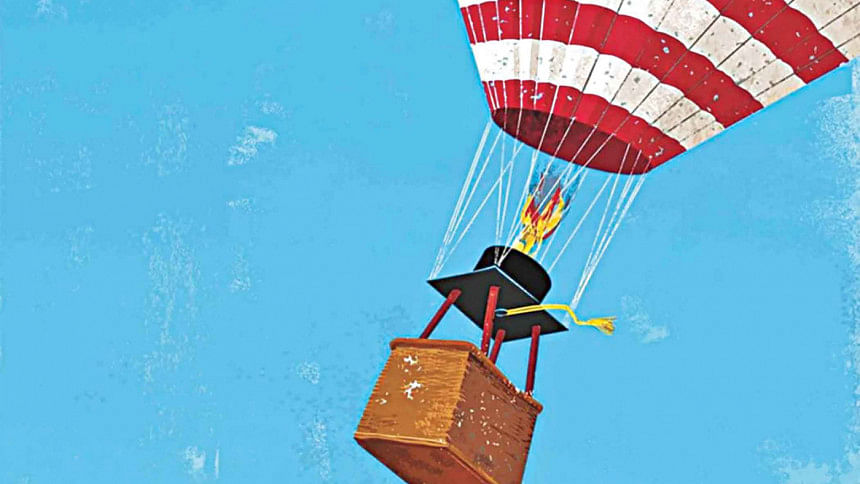The future contours of education in Bangladesh

Being in the era of the Fourth Industrial Revolution (4IR), let's consider two scenarios: In one, consortiums of universities no longer offer terminal degrees. They offer students a menu of courses to choose from and develop relevant skills to shape their own destinies. The general feeling is certificates and terminal degrees are overrated and useless. Employers also play a role by specifying combinations of courses that would meet specific job requirements. Upon completion, students are immediately connected to the (global) job market by another consortium of recruiting agencies.
In the second scenario, it is all artificial intelligence (AI) driven: financial and technology giants like Google, Amazon, Microsoft or some new goliath compile "useful" courses across disciplines (based on demand) and make them available to learners across the world who are subsequently linked to employers. There are no human teachers (many of them are overrated anyway) and the delivery of courses, assessment, grades, and certification are fair and quick (no human mistakes, irresponsible delays, or frailties that mess up these processes).

Millions of students, after their foundational learning is developed in their early years, converge on self-selected combinations of courses (avoiding the imposed requirements universities use to inflate revenues) aligned with their personal interests that are taught in interesting and engaging ways by challenging the mind rather than emphasising rote learning. The cost of a set of courses is also much lower because of economies of scale.
In this menu-driven system, one can exit from the learning stream at any time or jump into it to upskill and upgrade themselves for the next level in one's career: knowledge acquisition is self-driven! There are no age limits, no need to meet admission criteria (e.g., two first divisions or high GPAs), no more universities to go to, no more difficult and rogue teachers to deal with, optional payment plans, and so on.
Are the two scenarios really inconceivable or distant? That really depends on various factors and, of course, politics. For sure, there will be vigorous attempts to thwart the intrusion of the two scenarios. Regulators will impose impossible conditions; universities will rant and rage about the utility of job-aligned courses; teachers will lament their job losses and fight tooth and nail to keep AI out; administrators will push back because they lack in innovation and are resistant to change; and so on. Okay, AI is unlikely to be here soon. But what do we do in the meanwhile?
THE CONTEXT OF EDUCATION
To address any system, it is important first and foremost to understand the context – the strengths, weaknesses, opportunities and threats. Many accomplishments can be listed in this nation's 50-year journey. Poverty has been substantially reduced, health outcomes (infant mortality, maternal mortality, HIV/AIDS, cholera, life expectancy, etc.) are laudable, self-sufficiency in food (per capita) production has surpassed expectations, economic growth (powered by exports and remittances) is enviable, infrastructure growth is picking up pace (Padma Bridge, a major achievement in this regard), digital access is improving, family planning has achieved wonders, microfinance and SMEs have been a boon, and a thriving service industry is on the rise. Even our young cricketers have energised the nation with their flourish and flair (okay, with occasional disappointments). We are indeed a can-do nation!
In education, the backbone of any economy, there are also accomplishments of merit: spread of non-formal education, early childhood development, gender parity in early education, the growth of the education industry (especially private higher education), etc. But in this critical sector, challenges remain.
Primarily, investment in human capital has been stagnant. Halimur Khan (educator) points out the ramifications: We are [near] the bottom rung for many comparative indexes: 135th out of 189 countries in Human Development, 119th out of 193 in Global Development, 139th out of 162 in Human Freedom, and 116th out of 131 in Global Innovation—all in 2020.
AA Ziauddin (researcher) sees education policy across the entire subcontinent still framed in the British model of producing colonial administrators. There has not been much innovation here as it churns out half-educated, skill-deficient, and jobless graduates in their tens of thousands. The corporate world complains that it has had to turn to mid-level, sometimes apex, managers from abroad. All the while our graduates become a national burden and our supply of technicians continues to lag precipitously. Ziauddin observes, "I have come across a physics graduate working as a clerk; at the same time, a less literate welder was earning far more."
The National Student Assessment (NSA) Project showed that 35 percent of class 3 students did not score at the expected level in Bangla reading, and 43 percent could not answer simple questions from reading a Bangla passage. In math, 59 percent scored below the grade level. Disturbingly, when the grade 3 students reached grade 5 two years later in 2017, their performance was worse.
Bangladesh's workforce of 87 million is also largely undereducated (only 4 percent of workers have higher than secondary education). In general, students have weak reading skills and the curricula, teaching approaches, and examination systems at all levels focus more on rote learning than on competencies, critical thinking, and analytical skills (World Bank, 2019).
Low relevance of tertiary education and skills training is another issue of concern. The World Bank Enterprise Skills Survey 2012, for example, showed that employers believe graduates of Bangladesh's higher education programmes are inadequate for today's and tomorrow's labour market. Halimur Khan underscores that "…our university graduates are woefully unprepared to handle the challenges of the 21st century…a majority of them do not have the foundational literacies, competencies and the character qualities to be successful."
This remarkably rich region is, unfortunately, plagued by pockets of extreme poverty, mega-urbanisation, disparities between the rich and the poor, and rankling problems in the areas of infrastructure, energy and a deteriorating environment. The immediate challenges for the region are youth unemployment, poverty, economic development with equity, low level infrastructure, technological underdevelopment, undiversified industrialisation and exports, etc.
In this milieu, the education sector requires a fresh look. To be effective, our educational institutions must become much more useful and relevant. This is important because, "Workers of the future can expect to change occupations and careers several times and may even end up in jobs and industries that do not now exist…emerging technologies will continue to replace routine functions across many job categories at all levels, even as they create new opportunities for workers in hundreds of fields, including medicine and healthcare, manufacturing, and communications. These challenges will be amplified by the increasing competitiveness of other nations within the global economy, including the diversifying skill sets of foreign workers." Are our educational planners even aware of these emerging realities?
FINDING TRUE PURPOSE
What do we really want out of our education system? Who is education designed for? What outcomes are we seeking? How can the learning that is offered be made worthwhile? Our children are a reservoir of talent and energy. Properly guided into different streams, they can become raging rivers, turning barren earth into lush fields. Education must, therefore, build national capacity to support a viable, self-sustaining, and competitive nation, ready for the 21st century.
For example, "Singapore [transformed] from a low skill, low paid nation with high levels of illiteracy 50 years ago to a first world economy today, with a 1 percent unemployment rate [which] provides inspiration and hope for policy-makers everywhere."
Education reform in Singapore was "a way of retooling the productive capacity of the system." One writer argues that Singapore's education was not only instrumental in its "miraculous economic development but equally as a vehicle for promoting a cohesive civic identity, based on the ideological tripod of multiculturalism, multilingualism and meritocracy."
It must be emphasised that building our education system is not about copying Singapore or some other country. The key lies in figuring out: i) what is our winning aspiration; ii) where will we play (Agriculture, RMG, Construction, Information Technology, Healthcare, Financial Services, Security, Water Resources, Culinary Delights, or a combination of these or some other fields) in which we could potentially lead; iii) how will we lead and win (what is the unique value proposition of the strategic areas in which the nation will provide leadership); iv) what capabilities must be in place (can we tussle with the leaders in bio- or nano-technology or should we pick a niche and develop our own brand of intermediate technology); and v) what management systems are required to see the vision achieve success.
POWER AND CONTROL
A question that often emerges is: Who controls our education? The existence of four parallel systems starting at the school levels—government, NGOs, Madrasa, and Private English Medium—clearly indicates that power tussles remain unresolved. One might ask: Who controls the narrative about what our children should learn and how their thinking should evolve?
School children must first be given foundational skills and need not be separated into so many streams. Only around the 8th grade should attention be given to the different streams into which they ought to be channelled. All of this must be aligned with the overall purpose and mission of education (linked to national plans). Here technical and vocational schools with a blend of administrative training (TVAET) must also begin to play a much more vigorous role.
External influencers must also be better managed. This includes donors, development agencies, countries with vested interests, educational conglomerates, and so on. While they might extend a hand of assistance, their overt declarations may belie their self-interests. We must figure out their intent. It is important to remember that we have a demographic dividend to reap. If we can nurture this fabulous resource, it will give us a strategic advantage that may threaten the external influencers. But we must prioritise our own interests and remain steadfast in our vision, vigilance and constant creativity.

SYSTEM INTEGRATION AND EXTERNAL LINKAGES
Any education system cannot be run in a piecemeal and disjointed fashion; it must be designed as an integrated riverine system that flows from the mountain tops (primary education), spreading out to different regions (subjects/skills/majors), but culminating into larger rivers (the strategic industries—e.g., the RMG industry requires a complement of various skills), that ultimately merge with the ocean (the economy working as a smoothly aligned system). Every level must merge flawlessly into the next higher level.
As a supply chain system, it must allow anyone to step out of the flow at specific points (primary, junior secondary, secondary, higher secondary) for a variety of reasons (health, work, financial problems, family issues, etc.) and be allowed re-enter at their own choosing. If someone drops out after SSC for a certain period, (s)he should be allowed to re-enter the system as and when they are able to retool and upgrade. Otherwise, our Gross Enrolment Ratios of about 10 percent in higher education suggests that we lose 90 percent of a primary school cohort by the time they reach higher education.
Now, everyone need not be university-educated, but there is very little data about where the dropouts have gone and whether they are using the knowledge they have acquired. We don't even know what our university graduates are doing! The knowledge imparted at various levels is an investment; the returns must be clear. At every opt-out point, therefore, there must be a clear set of learning outcomes and competencies that must be ensured so that the entire system, lockstep, is held accountable for delivering.
External links are also vital and need continuous attention and nurture. According to Salehuddin Ahmed (economist, governor), "Education and training offered in formal institutions need to be recast to make these more relevant to the needs of the using sectors [employers, government] by establishing closer links."
THE FOUNDATIONS
Mirza Azizul Islam (educator, adviser) opines that "education is a lifelong journey, not a destination. Beyond the terminal degree, students should be encouraged to be [continuously] inquisitive about developments in diverse fields—social, political and economic."
In the current climate of globalisation, new forms of "global citizenship" have developed in which students are being prepared for entering the global workforce (Ng, 2012). While the implied standardised knowledge carries the risk of cultural imperialism, neo-colonialism, and spread of epistemological hegemonies (Rizvi, 2007), foundational excellence is a sine qua non. Halimur Khan suggests that in the early years, students must emerge with:
i) Strong reading, writing, speaking skills
ii) Quantitative and analytical skills
iii) Digital and basic technology skills
iv) Critical thinking, problem-solving, innovation orientation
v) General awareness of global issues
vi) Citizenship, integrity, courtesy, empathy, civic leadership, service to society
With progression to upper classes, learning should align with employers' interests and students must become problem solvers, communicators, teamwork-efficient, and technically adept (Apps, Big Data Analytics, Quantum Computing, Artificial Intelligence, Virtual Reality), in addition to attaining subject area skills.
Fazlul Aziz (educator) calls for instilling love for the country, importance of democratic norms, respect for people of every stratum of life, and the importance of honesty. Without moral foundations and a sense of history and social knowledge, we cannot imagine a better social order. To achieve this, responsibility lies not with teachers alone but also guardians, employers, government, and the students themselves. Learning must also be acculturated, lifelong.

MODERN LEARNING METHODS
In the last 50 years, the science of teaching and learning has evolved with particular groups in mind: pedagogy for children and andragogy for adults. Salehuddin Ahmed (former Pro-VC) counsels our universities to change from being simple certificate-issuing factories to becoming actual places of learning. Passing exams through rote memorisation should become passé as we are producing "operators" and "the compliant"—not thinkers and leaders. The following are important:
i) The minds of children and the youth are most receptive; they must be influenced early on.
ii) At all levels, modern methodologies of teaching must emphasise participation, problem solving, innovation, entrepreneurial thinking, and experiential learning. The lecture method has become decrepit.
iii) Both teachers and management need to be more student centric, listening to them carefully and consciously. Teachers and students can shape each other in an environment of co-creation of knowledge.
iv) A university cannot be run as an NGO or a "business" with a profit motive: It must encourage freedom of thinking, writing, and speaking which represent the essence of a university.
TECHNOLOGY
Learning will be redefined in a world where the answer to every question is only one Google, Siri or Alexa search away. Pointless memorisation should soon lose its significance while analysis and problem-solving rise in importance.
The world of 4IR and commensurate technologies must become intimately familiar to our students as in many Asian countries. Policy initiatives are needed to increase technology adoption as early as possible in all places of learning.
Because of AI and new algorithms (e.g., IBM's Watson), even lawyers and doctors are becoming redundant. Many fields that currently provide lucrative employment opportunities are vanishing rapidly. How our huge manpower base can be made more responsive to changes in a technology-aggressive world must be clearly understood and shared.
Mahreen Mamun (educator) contends that with the help of digital media, while cost cutting is possible in many areas, it can be also be used for teacher development and teacher education as a whole new paradigm. Government and policymakers must find innovative ways to train the teachers and monitor them with the help of new digital platforms so that learning and teaching become more modern, transparent and accountable. It is never easy to change a system, especially one that has many ingrained features. Hopefully, the pandemic has helped jolt the system to reboot our thinking about adopting new ways of teaching and learning.
NATIONAL DATABASE
Little is known about the causes of variation and differences in the quality of education imparted across academia. Part of the problem lies in our educational administrators—from the ministry down to the institutional level—having little interest in or understanding of the use of data to manage their ambit of operations. A simple piece of information—how many classes were missed by teachers at a school, college or university—can trigger effective managerial responses to correct the system. But administrators are blissfully unaware of even basic operational problems and difficulties. Most of our institutions are run by intuition, guesswork or sheer bull-headed arrogance that cannot be challenged. Systems are reactive, not proactive. Efficiency and effectiveness—both suffer egregiously.
A set of national experts must be assembled to chart out information needs of the system: What data should be gathered, from whom, at what frequency, to what purpose, and disseminated to whom—these are basic issues that remain unaddressed. In the hands of the team, supported by an able IT staff, it should become easy to monitor the heartbeat of the system, especially key indicators, so that outliers and irregularities can be brought into alignment. At a well-known institution, classes were being missed by faculty regularly and students were not getting their money's worth. Once data began to be gathered, the problem dropped dramatically.
INCENTIVE STRUCTURES
Teachers have been roundly blamed for many of the woes of the education system. Are they fully to blame?
For example, new recruits are thrust into classrooms with little to no preparation, few resources, poor facilities, and lacking in support for the job (s)he needs to do. The budget to build human capital is also woefully inadequate.
In the military or the government, competencies are developed with continuous training. Banks and corporate bodies are also investing in the same. Why are our teachers so neglected? More than 95 percent of the education budget goes to support remuneration (though I took a slightly different position on this in an earlier op-ed). The rest is for development? This is what our education planning bodies are capable of designing? It must also be acknowledged that there are poor teachers at all levels. Some are arrogant and neglect their duties as a teacher. The Student Experience Project (reported in the Daily Star) reveals the gamut of issues that students face from teachers. Even if these teachers are given the proper support, will they try to improve? No one believes they would work harder if poor teachers are rewarded equally as excellent teachers (in raises, promotions, opportunities, etc.).
The incentive structure must change. In higher education, for example, Saleemul Huq proposes that university authorities must reward research and innovation as must the national government by providing funding. He exhorts that, as a country, we will remain underdeveloped as long as we remain dependent on international consultants to supplement knowledge. We must thus generate our own body of knowledge (research) relevant to our own context. Competitive incentives must also be considered by advocating open-door policy in recruitment for our universities. With a blend of foreign teachers, cross-fertilisation rather than in-breeding will make our education system stronger, more resilient, competitive, and innovative. We emphasise that East Asian countries—South Korea, Hong Kong, Singapore, (and now) Malaysia, etc.—gained in recognition and ranking (rather quickly) by inviting foreign faculty to their campuses. While costs will be an issue, it is preferable to see it as value (results/costs) addition. A good place to start is our diaspora scholars who are knowledgeable and wish to give back.
The subject of incentives is complex and consideration must be given not just to the individual level (faculty), but also to the group level (department), stage of education (BA, MA, MPhil, PhD), institutional level (university), and partners (government, private sector—for their involvement and contributions).
GOVERNANCE
Governance is the piece that ought to tie all other pieces together. Sadly, some see governance in the education system at all levels as abysmal. In public universities, it is believed that teachers are appointed based on their political inclinations. Some misuse their freedom and do not even take any classes; instead of being fired, they still get paid. Promotion criteria are obsolete where teachers can become full professors with lacklustre teaching and poor research contributions. In the private universities, the quality of education varies widely. Almost all founders brazenly influence the university administration and faculty members in ways that are not conducive for quality education. In these universities, research is not given due importance—it is considered to be unprofitable.
Raihan Jamil (educator) contends that "certain [faculty] of higher education are not interested in education at all. These individuals have little interest in teaching or learning, and the students become direct victims." They must be culled from the system if we want education to rise in efficacy and stature.
Corruption at various tiers of the education system is also widespread with fees, coaching, unfair practices, misuse of power, and a plethora of ills that fill the pockets of many teachers and degrade the profession. Unless good governance intervenes to weed out these crass anomalies in education, not much will change for the better.
CONCLUSIONS
The single greatest national asset today is our youth—our demographic dividend. If we are able to educate them better, we can indeed transition to a significantly elevated knowledge-based economy delivering sharply heightened benefits to the citizenry. This will require setting a clear and measurable purpose of education, with ownership that serves our national interests, integrated as a faultless supply chain all the way to the (global) market, with strong foundational education, taught using modern methods (replacing lectures and exams), augmented with 4IR technology, coordinated and aligned with an efficient data system, invigorated with proper incentive structures, and managed by professionals, to shift to an enviable paradigm that builds human capital to its limits.
As Fakhrul Alam (educator) contends, "Our education system, ideally, must be places for learning creatively and for fostering creativity. Places where merit is measured at every step and then rewarded… Places for the common pursuit of higher forms of knowledge and inculcating humane values and not for self-centred learning."
To build an education system that is purpose-driven, self-correcting and innovative, there will be challenges: we must meet them resolutely, collectively, ambitiously, creatively, and boldly—most of all with ownership, purpose and a mission that are in line with national aspirations, truly enlightening, and delightfully liberating.
Dr Syed Saad Andaleeb is former Vice Chancellor, BRAC University; Distinguished Visiting Professor, IBA, University of Dhaka; and Distinguished Professor Emeritus, Pennsylvania State University, USA.
Author's Note: In putting together this article, I turned to my friends, colleagues and students for insights. Many of them (noted in the text) responded with thoughtful suggestions. As a result, it reflects collective wisdom. Their thoughts blended with mine resulted in a sort of a roadmap, with a warning that the devil is in the details!

 For all latest news, follow The Daily Star's Google News channel.
For all latest news, follow The Daily Star's Google News channel. 



Comments